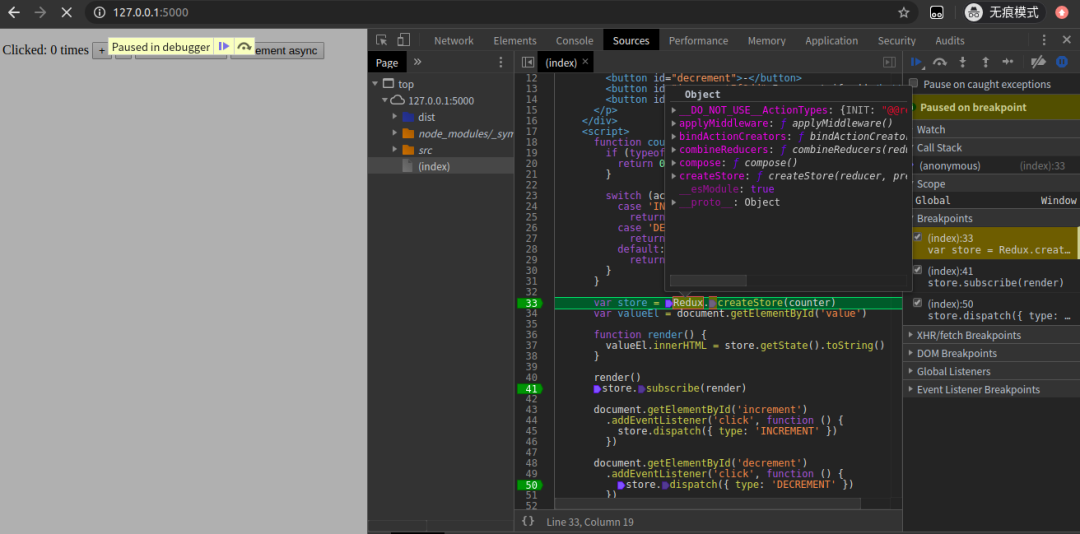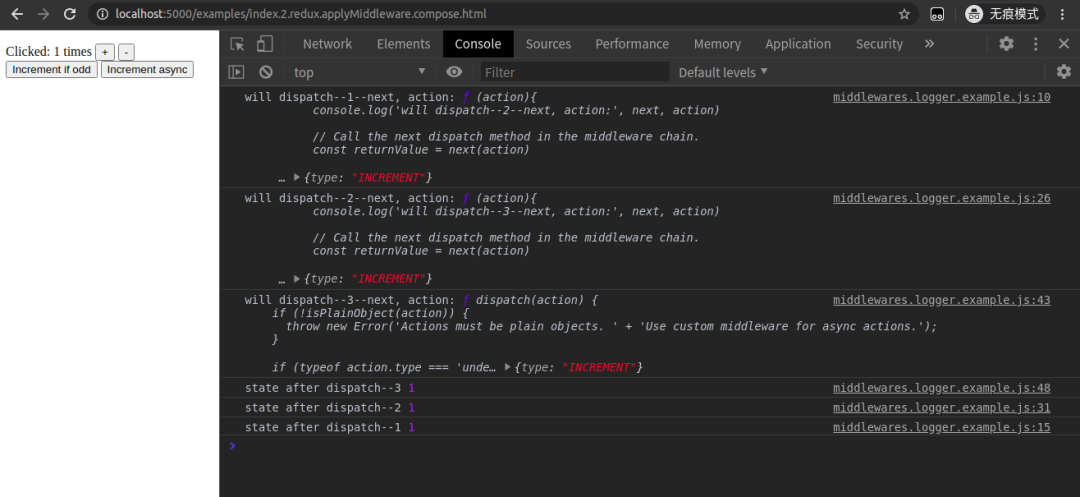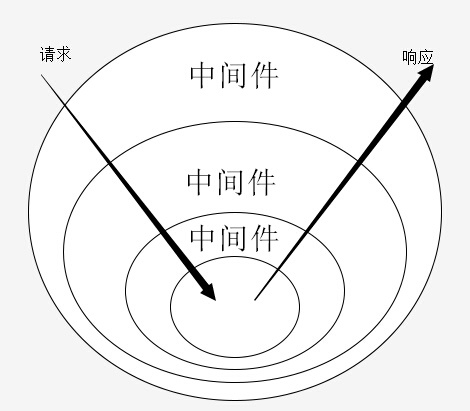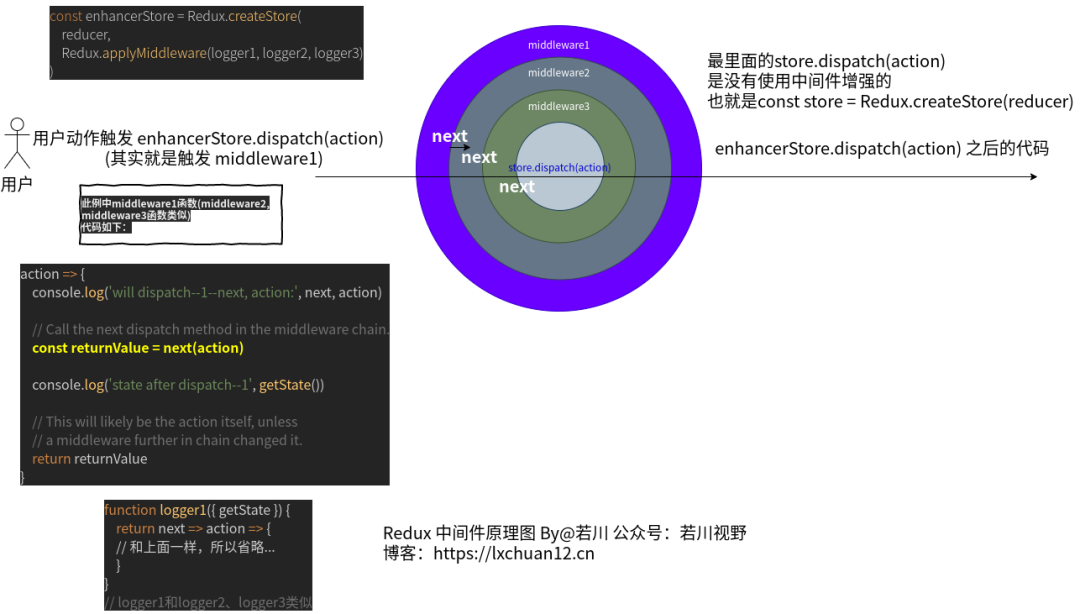阅读本文你将学到:
git subtree管理子仓库- 如何学习
redux源码redux中间件原理redux各个API的实现vuex和redux的对比- 等等
把我的redux源码仓库 git clone https://github.com/lxchuan12/redux-analysis.git克隆下来,顺便star一下我的redux源码学习仓库^_^。跟着文章节奏调试和示例代码调试,用chrome动手调试印象更加深刻。文章长段代码不用细看,可以调试时再细看。看这类源码文章百遍,可能不如自己多调试几遍。也欢迎加我微信交流ruochuan12。
写了很多源码文章,vuex、axios、koa等都是使用新的仓库克隆一份源码在自己仓库中。虽然电脑可以拉取最新代码,看到原作者的git信息。但上传到github后。读者却看不到原仓库作者的git信息了。于是我找到了git submodules 方案,但并不是很适合。再后来发现了git subtree。
简单说下 npm package和git subtree的区别。npm package是单向的。git subtree则是双向的。
具体可以查看这篇文章@德来(原有赞大佬):用 Git Subtree 在多个 Git 项目间双向同步子项目,附简明使用手册
学会了git subtree后,我新建了redux-analysis项目后,把redux源码4.x(截止至2020年06月13日,4.x分支最新版本是4.0.5,master分支是ts,文章中暂不想让一些不熟悉ts的读者看不懂)分支克隆到了我的项目里的一个子项目,得以保留git信息。
对应命令则是:
git subtree add --prefix=redux https://github.com/reduxjs/redux.git 4.x
之前,我在知乎回答了一个问题若川:一年内的前端看不懂前端框架源码怎么办?推荐了一些资料,阅读量还不错,大家有兴趣可以看看。主要有四点:
1.借助调试 2.搜索查阅相关高赞文章 3.把不懂的地方记录下来,查阅相关文档 4.总结
看源码调试很重要,所以我的每篇源码文章都详细描述(也许有人看来是比较啰嗦...)如何调试源码。
断点调试要领: 赋值语句可以一步按
F10跳过,看返回值即可,后续详细再看。 函数执行需要断点按F11跟着看,也可以结合注释和上下文倒推这个函数做了什么。 有些不需要细看的,直接按F8走向下一个断点 刷新重新调试按F5
调试源码前,先简单看看 redux 的工作流程,有个大概印象。

修改rollup.config.js文件,output输出的配置生成sourcemap。
// redux/rollup.config.js 有些省略
const sourcemap = {
sourcemap: true,
};
output: {
// ...
...sourcemap,
}安装依赖
git clone http://github.com/lxchuan12/redux-analysis.git
cd redux-analysi/redux
npm i
npm run build
# 编译结束后会生成 sourcemap .map格式的文件到 dist、es、lib 目录下。仔细看看redux/examples目录和redux/README。
这时我在根路径下,新建文件夹examples,把原生js写的计数器redux/examples/counter-vanilla/index.html,复制到examples/index.html。同时把打包后的包含sourcemap的redux/dist目录,复制到examples/dist目录。
修改index.html的script的redux.js文件为dist中的路径。
为了便于区分和调试后续
html文件,我把index.html重命名为index.1.redux.getState.dispatch.html。
# redux-analysis 根目录
# 安装启动服务的npm包
npm i -g http-server
cd examples
hs -p 5000就可以开心的调试啦。可以直接克隆我的项目git clone http://github.com/lxchuan12/redux-analysis.git。本地调试,动手实践,容易消化吸收。
接着我们来看examples/index.1.redux.getState.dispatch.html文件。先看html部分。只是写了几个 button,比较简单。
<div>
<p>
Clicked: <span id="value">0</span> times
<button id="increment">+</button>
<button id="decrement">-</button>
<button id="incrementIfOdd">Increment if odd</button>
<button id="incrementAsync">Increment async</button>
</p>
</div>js部分,也比较简单。声明了一个counter函数,传递给Redux.createStore(counter),得到结果store,而store是个对象。render方法渲染数字到页面。用store.subscribe(render)订阅的render方法。还有store.dispatch({type: 'INCREMENT' })方法,调用store.dispatch时会触发render方法。这样就实现了一个计数器。
function counter(state, action) {
if (typeof state === 'undefined') {
return 0
}
switch (action.type) {
case 'INCREMENT':
return state + 1
case 'DECREMENT':
return state - 1
default:
return state
}
}
var store = Redux.createStore(counter)
var valueEl = document.getElementById('value')
function render() {
valueEl.innerHTML = store.getState().toString()
}
render()
store.subscribe(render)
document.getElementById('increment')
.addEventListener('click', function () {
store.dispatch({ type: 'INCREMENT' })
})
// 省略部分暂时无效代码...思考:看了这段代码,你会在哪打断点来调试呢。
// 四处可以断点来看
// 1.
var store = Redux.createStore(counter)
// 2.
function render() {
valueEl.innerHTML = store.getState().toString()
}
render()
// 3.
store.subscribe(render)
// 4.
store.dispatch({ type: 'INCREMENT' })
图中的右边Scope,有时需要关注下,会显示闭包、全局环境、当前环境等变量,还可以显示函数等具体代码位置,能帮助自己理解代码。
断点调试,按F5刷新页面后,按F8,把鼠标放在Redux和store上。
可以看到Redux上有好几个方法。分别是:
store.dispatch函数,dispatch时,可以串联执行所有中间件。react-redux。reducers,返回一个总的reducer函数。store 对象再看store也有几个方法。分别是:
subscribe收集的函数,依次遍历执行dispatch依次执行。返回一个取消订阅的函数,可以取消订阅监听。createStore函数内部闭包的对象。redux开发者工具,对比当前和上一次操作的异同。有点类似时间穿梭功能。也就是官方文档redux.org.js上的 API。
暂时不去深究每一个API的实现。重新按F5刷新页面,断点到var store = Redux.createStore(counter)。一直按F11,先走一遍主流程。
createStore 函数结构是这样的,是不是看起来很简单,最终返回对象store,包含dispatch、subscribe、getState、replaceReducer等方法。
// 省略了若干代码
export default function createStore(reducer, preloadedState, enhancer) {
// 省略参数校验和替换
// 当前的 reducer 函数
let currentReducer = reducer
// 当前state
let currentState = preloadedState
// 当前的监听数组函数
let currentListeners = []
// 下一个监听数组函数
let nextListeners = currentListeners
// 是否正在dispatch中
let isDispatching = false
function ensureCanMutateNextListeners() {
if (nextListeners === currentListeners) {
nextListeners = currentListeners.slice()
}
}
function getState() {
return currentState
}
function subscribe(listener) {}
function dispatch(action) {}
function replaceReducer(nextReducer) {}
function observable() {}
// ActionTypes.INIT @@redux/INITu.v.d.u.6.r
dispatch({ type: ActionTypes.INIT })
return {
dispatch,
subscribe,
getState,
replaceReducer,
[$$observable]: observable
}
}function dispatch(action) {
// 判断action是否是对象,不是则报错
if (!isPlainObject(action)) {
throw new Error(
'Actions must be plain objects. ' +
'Use custom middleware for async actions.'
)
}
// 判断action.type 是否存在,没有则报错
if (typeof action.type === 'undefined') {
throw new Error(
'Actions may not have an undefined "type" property. ' +
'Have you misspelled a constant?'
)
}
// 不是则报错
if (isDispatching) {
throw new Error('Reducers may not dispatch actions.')
}
try {
isDispatching = true
currentState = currentReducer(currentState, action)
} finally {
// 调用完后置为 false
isDispatching = false
}
// 把 收集的函数拿出来依次调用
const listeners = (currentListeners = nextListeners)
for (let i = 0; i < listeners.length; i++) {
const listener = listeners[i]
listener()
}
// 最终返回 action
return action
}
var store = Redux.createStore(counter)
上文调试完了这句。
继续按F11调试。
function render() {
valueEl.innerHTML = store.getState().toString()
}
render()getState函数实现比较简单。
function getState() {
// 判断正在dispatch中,则报错
if (isDispatching) {
throw new Error(
'You may not call store.getState() while the reducer is executing. ' +
'The reducer has already received the state as an argument. ' +
'Pass it down from the top reducer instead of reading it from the store.'
)
}
// 返回当前的state
return currentState
}订阅监听函数,存放在数组中,store.dispatch(action)时遍历执行。
function subscribe(listener) {
// 订阅参数校验不是函数报错
if (typeof listener !== 'function') {
throw new Error('Expected the listener to be a function.')
}
// 正在dispatch中,报错
if (isDispatching) {
throw new Error(
'You may not call store.subscribe() while the reducer is executing. ' +
'If you would like to be notified after the store has been updated, subscribe from a ' +
'component and invoke store.getState() in the callback to access the latest state. ' +
'See https://redux.js.org/api-reference/store#subscribelistener for more details.'
)
}
// 订阅为 true
let isSubscribed = true
ensureCanMutateNextListeners()
nextListeners.push(listener)
// 返回一个取消订阅的函数
return function unsubscribe() {
if (!isSubscribed) {
return
}
// 正在dispatch中,则报错
if (isDispatching) {
throw new Error(
'You may not unsubscribe from a store listener while the reducer is executing. ' +
'See https://redux.js.org/api-reference/store#subscribelistener for more details.'
)
}
// 订阅为 false
isSubscribed = false
ensureCanMutateNextListeners()
// 找到当前监听函数
const index = nextListeners.indexOf(listener)
// 在数组中删除
nextListeners.splice(index, 1)
currentListeners = null
}
}到这里,我们就调试学习完了Redux.createSotre、store.dispatch、store.getState、store.subscribe的源码。
接下来,我们写个中间件例子,来调试中间件相关源码。
中间件是重点,面试官也经常问这类问题。
为了调试Redux.applyMiddleware(...middlewares),我在examples/js/middlewares.logger.example.js写一个简单的logger例子。分别有三个logger1,logger2,logger3函数。由于都是类似,所以我在这里只展示logger1函数。
// examples/js/middlewares.logger.example.js
function logger1({ getState }) {
return next => action => {
console.log('will dispatch--1--next, action:', next, action)
// Call the next dispatch method in the middleware chain.
const returnValue = next(action)
console.log('state after dispatch--1', getState())
// This will likely be the action itself, unless
// a middleware further in chain changed it.
return returnValue
}
}
// 省略 logger2、logger3logger中间件函数做的事情也比较简单,返回两层函数,next就是下一个中间件函数,调用返回结果。为了让读者能看懂,我把logger1用箭头函数、logger2则用普通函数。
写好例子后,我们接着来看怎么调试Redux.applyMiddleware(...middlewares))源码。
cd redux-analysis && hs -p 5000
# 上文说过npm i -g http-server打开http://localhost:5000/examples/index.2.redux.applyMiddleware.compose.html,按F12打开控制台,
先点击加号操作+1,把结果展示出来。

从图中可以看出,next则是下一个函数。先1-2-3,再3-2-1这样的顺序。
这种也就是我们常说的中间件,面向切面编程(AOP)。

接下来调试,在以下语句打上断点和一些你觉得重要的地方打上断点。
// examples/index.2.redux.applyMiddleware.compose.html
var store = Redux.createStore(counter, Redux.applyMiddleware(logger1, logger2, logger3))// redux/src/applyMiddleware.js
/**
* ...
* @param {...Function} middlewares The middleware chain to be applied.
* @returns {Function} A store enhancer applying the middleware.
*/
export default function applyMiddleware(...middlewares) {
return createStore => (...args) => {
const store = createStore(...args)
let dispatch = () => {
throw new Error(
'Dispatching while constructing your middleware is not allowed. ' +
'Other middleware would not be applied to this dispatch.'
)
}
const middlewareAPI = {
getState: store.getState,
dispatch: (...args) => dispatch(...args)
}
const chain = middlewares.map(middleware => middleware(middlewareAPI))
dispatch = compose(...chain)(store.dispatch)
return {
...store,
dispatch
}
}
}// redux/src/createStore.js
export default function createStore(reducer, preloadedState, enhancer) {
// 省略参数校验
// 如果第二个参数`preloadedState`是函数,并且第三个参数`enhancer`是undefined,把它们互换一下。
if (typeof preloadedState === 'function' && typeof enhancer === 'undefined') {
enhancer = preloadedState
preloadedState = undefined
}
if (typeof enhancer !== 'undefined') {
if (typeof enhancer !== 'function') {
throw new Error('Expected the enhancer to be a function.')
}
// enhancer 也就是`Redux.applyMiddleware`返回的函数
// createStore 的 args 则是 `reducer, preloadedState`
/**
* createStore => (...args) => {
const store = createStore(...args)
return {
...store,
dispatch,
}
}
** /
// 最终返回增强的store对象。
return enhancer(createStore)(reducer, preloadedState)
}
// 省略后续代码
}把接收的中间件函数logger1, logger2, logger3放入到 了middlewares数组中。Redux.applyMiddleware最后返回两层函数。把中间件函数都混入了参数getState和dispatch。
// examples/index.2.redux.applyMiddleware.compose.html
var store = Redux.createStore(counter, Redux.applyMiddleware(logger1, logger2, logger3))最后这句其实是返回一个增强了dispatch的store对象。
而增强的dispatch函数,则是用Redux.compose(...functions)进行串联起来执行的。
export default function compose(...funcs) {
if (funcs.length === 0) {
return arg => arg
}
if (funcs.length === 1) {
return funcs[0]
}
return funcs.reduce((a, b) => (...args) => a(b(...args)))
}// applyMiddleware.js
dispatch = compose(...chain)(store.dispatch)
// compose
funcs.reduce((a, b) => (...args) => a(b(...args)))这两句可能不是那么好理解,可以断点多调试几次。我把箭头函数转换成普通函数。
funcs.reduce(function(a, b){
return function(...args){
return a(b(...args));
};
});其实redux源码中注释很清晰了,这个compose函数上方有一堆注释,其中有一句:组合多个函数,从右到左,比如:compose(f, g, h) 最终得到这个结果 (...args) => f(g(h(...args))).
看Redux.compose(...functions)函数源码后,还是不明白,不要急不要慌,吃完鸡蛋还有汤。仔细来看如何演化而来,先来简单看下如下需求。
传入一个数值,计算数值乘以10再加上10,再减去2。
实现起来很简单。
const calc = (num) => num * 10 + 10 - 2;
calc(10); // 108但这样写有个问题,不好扩展,比如我想乘以10时就打印出结果。为了便于扩展,我们分开写成三个函数。
const multiply = (x) => {
const result = x * 10;
console.log(result);
return result;
};
const add = (y) => y + 10;
const minus = (z) => z - 2;
// 计算结果
console.log(minus(add(multiply(10))));
// 100
// 108
// 这样我们就把三个函数计算结果出来了。再来实现一个相对通用的函数,计算这三个函数的结果。
const compose = (f, g, h) => {
return function(x){
return f(g(h(x)));
}
}
const calc = compose(minus, add, multiply);
console.log(calc(10));
// 100
// 108这样还是有问题,只支持三个函数。我想支持多个函数。我们了解到数组的reduce方法就能实现这样的功能。前一个函数
// 我们常用reduce来计算数值数组的总和
[1,2,3,4,5].reduce((pre, item, index, arr) => {
console.log('(pre, item, index, arr)', pre, item, index, arr);
// (pre, item, index, arr) 1 2 1 (5) [1, 2, 3, 4, 5]
// (pre, item, index, arr) 3 3 2 (5) [1, 2, 3, 4, 5]
// (pre, item, index, arr) 6 4 3 (5) [1, 2, 3, 4, 5]
// (pre, item, index, arr) 10 5 4 (5) [1, 2, 3, 4, 5]
return pre + item;
});
// 15pre 是上一次返回值,在这里是数值1,3,6,10。在下一个例子中则是匿名函数。
function(x){
return a(b(x));
}item是2,3,4,5,在下一个例子中是minus、add、multiply。
const compose = (...funcs) => {
return funcs.reduce((a, b) => {
return function(x){
return a(b(x));
}
})
}
const calc = compose(minus, add, multiply);
console.log(calc(10));
// 100
// 108而Redux.compose(...functions)其实就是这样,只不过中间件是返回双层函数罢了。
所以返回的是next函数,他们串起来执行了,形成了中间件的洋葱模型。人们都说一图胜千言。我画了一个相对简单的redux中间件原理图。

redux中间件原理图
如果还不是很明白,建议按照我给出的例子,多调试。
cd redux-analysis && hs -p 5000
# 上文说过npm i -g http-server打开http://localhost:5000/examples/index.3.html,按F12打开控制台调试。
lodash源码中 compose函数的实现,也是类似于数组的reduce,只不过是内部实现的arrayReduce
引用自我的文章:学习lodash源码整体架构
// lodash源码
function baseWrapperValue(value, actions) {
var result = value;
// 如果是lazyWrapper的实例,则调用LazyWrapper.prototype.value 方法,也就是 lazyValue 方法
if (result instanceof LazyWrapper) {
result = result.value();
}
// 类似 [].reduce(),把上一个函数返回结果作为参数传递给下一个函数
return arrayReduce(actions, function(result, action) {
return action.func.apply(action.thisArg, arrayPush([result], action.args));
}, result);
}koa-compose源码也有compose函数的实现。实现是循环加promise。由于代码比较长我就省略了,具体看链接若川:学习 koa 源码的整体架构,浅析koa洋葱模型原理和co原理小节 koa-compose 源码(洋葱模型实现)
打开http://localhost:5000/examples/index.4.html,按F12打开控制台,按照给出的例子,调试接下来的Redux.combineReducers(reducers)和Redux.bindActionCreators(actionCreators, dispatch)具体实现。由于文章已经很长了,这两个函数就不那么详细解释了。
combineReducers函数简单来说就是合并多个reducer为一个函数combination。
export default function combineReducers(reducers) {
const reducerKeys = Object.keys(reducers)
const finalReducers = {}
for (let i = 0; i < reducerKeys.length; i++) {
const key = reducerKeys[i]
// 省略一些开发环境判断的代码...
if (typeof reducers[key] === 'function') {
finalReducers[key] = reducers[key]
}
}
// 经过一些处理后得到最后的finalReducerKeys
const finalReducerKeys = Object.keys(finalReducers)
// 省略一些开发环境判断的代码...
return function combination(state = {}, action) {
// ... 省略开发环境的一些判断
// 用 hasChanged变量 记录前后 state 是否已经修改
let hasChanged = false
// 声明对象来存储下一次的state
const nextState = {}
//遍历 finalReducerKeys
for (let i = 0; i < finalReducerKeys.length; i++) {
const key = finalReducerKeys[i]
const reducer = finalReducers[key]
const previousStateForKey = state[key]
// 执行 reducer
const nextStateForKey = reducer(previousStateForKey, action)
// 省略容错代码 ...
nextState[key] = nextStateForKey
// 两次 key 对比 不相等则发生改变
hasChanged = hasChanged || nextStateForKey !== previousStateForKey
}
// 最后的 keys 数组对比 不相等则发生改变
hasChanged =
hasChanged || finalReducerKeys.length !== Object.keys(state).length
return hasChanged ? nextState : state
}
}如果第一个参数是一个函数,那就直接返回一个函数。如果是一个对象,则遍历赋值,最终生成boundActionCreators对象。
function bindActionCreator(actionCreator, dispatch) {
return function() {
return dispatch(actionCreator.apply(this, arguments))
}
}
export default function bindActionCreators(actionCreators, dispatch) {
if (typeof actionCreators === 'function') {
return bindActionCreator(actionCreators, dispatch)
}
// ... 省略一些容错判断
const boundActionCreators = {}
for (const key in actionCreators) {
const actionCreator = actionCreators[key]
if (typeof actionCreator === 'function') {
boundActionCreators[key] = bindActionCreator(actionCreator, dispatch)
}
}
return boundActionCreators
}redux所提供的的API 除了store.replaceReducer(nextReducer)没分析,其他都分析了。
从源码实现上来看,vuex源码主要使用了构造函数,而redux则是多用函数式编程、闭包。
vuex 与 vue 强耦合,脱离了vue则无法使用。而redux跟react没有关系,所以它可以使用于小程序或者jQuery等。如果需要和react使用,还需要结合react-redux库。
// logger 插件,具体实现省略
function logger (store) {
console.log('store', store);
}
// 作为数组传入
new Vuex.Store({
state,
getters,
actions,
mutations,
plugins: process.env.NODE_ENV !== 'production'
? [logger]
: []
})
// vuex 源码 插件执行部分
class Store{
constructor(){
// 把vuex的实例对象 store整个对象传递给插件使用
plugins.forEach(plugin => plugin(this))
}
}vuex实现扩展则是使用插件形式,而redux是中间件的形式。redux的中间件则是AOP(面向切面编程),redux中Redux.applyMiddleware()其实也是一个增强函数,所以也可以用户来实现增强器,所以redux生态比较繁荣。
相对来说,vuex上手相对简单,redux相对难一些,redux涉及到一些函数式编程、高阶函数、纯函数等概念。
文章主要通过一步步调试的方式循序渐进地讲述redux源码的具体实现。旨在教会读者调试源码,不惧怕源码。
面试官经常喜欢考写一个redux中间件,说说redux中间件的原理。
function logger1({ getState }) {
return next => action => {
const returnValue = next(action)
return returnValue
}
}const compose = (...funcs) => {
if (funcs.length === 0) {
return arg => arg
}
if (funcs.length === 1) {
return funcs[0]
}
// 箭头函数
// return funcs.reduce((a, b) => (...args) => a(b(...args)))
return funcs.reduce((a, b) => {
return function(x){
return a(b(x));
}
})
}const enhancerStore = Redux.create(reducer, Redux.applyMiddleware(logger1, ...))
enhancerStore.dispatch(action)用户触发enhancerStore.dispatch(action)是增强后的,其实就是第一个中间件函数,中间的next是下一个中间件函数,最后next是没有增强的store.dispatch(action)。
最后再来看张redux工作流程图
是不是就更理解些了呢。
本文由哈喽比特于3年以前收录,如有侵权请联系我们。
文章来源:https://mp.weixin.qq.com/s/ZjcapRb2eyo6W-EDTXD8vQ
京东创始人刘强东和其妻子章泽天最近成为了互联网舆论关注的焦点。有关他们“移民美国”和在美国购买豪宅的传言在互联网上广泛传播。然而,京东官方通过微博发言人发布的消息澄清了这些传言,称这些言论纯属虚假信息和蓄意捏造。
日前,据博主“@超能数码君老周”爆料,国内三大运营商中国移动、中国电信和中国联通预计将集体采购百万台规模的华为Mate60系列手机。
据报道,荷兰半导体设备公司ASML正看到美国对华遏制政策的负面影响。阿斯麦(ASML)CEO彼得·温宁克在一档电视节目中分享了他对中国大陆问题以及该公司面临的出口管制和保护主义的看法。彼得曾在多个场合表达了他对出口管制以及中荷经济关系的担忧。
今年早些时候,抖音悄然上线了一款名为“青桃”的 App,Slogan 为“看见你的热爱”,根据应用介绍可知,“青桃”是一个属于年轻人的兴趣知识视频平台,由抖音官方出品的中长视频关联版本,整体风格有些类似B站。
日前,威马汽车首席数据官梅松林转发了一份“世界各国地区拥车率排行榜”,同时,他发文表示:中国汽车普及率低于非洲国家尼日利亚,每百户家庭仅17户有车。意大利世界排名第一,每十户中九户有车。
近日,一项新的研究发现,维生素 C 和 E 等抗氧化剂会激活一种机制,刺激癌症肿瘤中新血管的生长,帮助它们生长和扩散。
据媒体援引消息人士报道,苹果公司正在测试使用3D打印技术来生产其智能手表的钢质底盘。消息传出后,3D系统一度大涨超10%,不过截至周三收盘,该股涨幅回落至2%以内。
9月2日,坐拥千万粉丝的网红主播“秀才”账号被封禁,在社交媒体平台上引发热议。平台相关负责人表示,“秀才”账号违反平台相关规定,已封禁。据知情人士透露,秀才近期被举报存在违法行为,这可能是他被封禁的部分原因。据悉,“秀才”年龄39岁,是安徽省亳州市蒙城县人,抖音网红,粉丝数量超1200万。他曾被称为“中老年...
9月3日消息,亚马逊的一些股东,包括持有该公司股票的一家养老基金,日前对亚马逊、其创始人贝索斯和其董事会提起诉讼,指控他们在为 Project Kuiper 卫星星座项目购买发射服务时“违反了信义义务”。
据消息,为推广自家应用,苹果现推出了一个名为“Apps by Apple”的网站,展示了苹果为旗下产品(如 iPhone、iPad、Apple Watch、Mac 和 Apple TV)开发的各种应用程序。
特斯拉本周在美国大幅下调Model S和X售价,引发了该公司一些最坚定支持者的不满。知名特斯拉多头、未来基金(Future Fund)管理合伙人加里·布莱克发帖称,降价是一种“短期麻醉剂”,会让潜在客户等待进一步降价。
据外媒9月2日报道,荷兰半导体设备制造商阿斯麦称,尽管荷兰政府颁布的半导体设备出口管制新规9月正式生效,但该公司已获得在2023年底以前向中国运送受限制芯片制造机器的许可。
近日,根据美国证券交易委员会的文件显示,苹果卫星服务提供商 Globalstar 近期向马斯克旗下的 SpaceX 支付 6400 万美元(约 4.65 亿元人民币)。用于在 2023-2025 年期间,发射卫星,进一步扩展苹果 iPhone 系列的 SOS 卫星服务。
据报道,马斯克旗下社交平台𝕏(推特)日前调整了隐私政策,允许 𝕏 使用用户发布的信息来训练其人工智能(AI)模型。新的隐私政策将于 9 月 29 日生效。新政策规定,𝕏可能会使用所收集到的平台信息和公开可用的信息,来帮助训练 𝕏 的机器学习或人工智能模型。
9月2日,荣耀CEO赵明在采访中谈及华为手机回归时表示,替老同事们高兴,觉得手机行业,由于华为的回归,让竞争充满了更多的可能性和更多的魅力,对行业来说也是件好事。
《自然》30日发表的一篇论文报道了一个名为Swift的人工智能(AI)系统,该系统驾驶无人机的能力可在真实世界中一对一冠军赛里战胜人类对手。
近日,非营利组织纽约真菌学会(NYMS)发出警告,表示亚马逊为代表的电商平台上,充斥着各种AI生成的蘑菇觅食科普书籍,其中存在诸多错误。
社交媒体平台𝕏(原推特)新隐私政策提到:“在您同意的情况下,我们可能出于安全、安保和身份识别目的收集和使用您的生物识别信息。”
2023年德国柏林消费电子展上,各大企业都带来了最新的理念和产品,而高端化、本土化的中国产品正在不断吸引欧洲等国际市场的目光。
罗永浩日前在直播中吐槽苹果即将推出的 iPhone 新品,具体内容为:“以我对我‘子公司’的了解,我认为 iPhone 15 跟 iPhone 14 不会有什么区别的,除了序(列)号变了,这个‘不要脸’的东西,这个‘臭厨子’。









